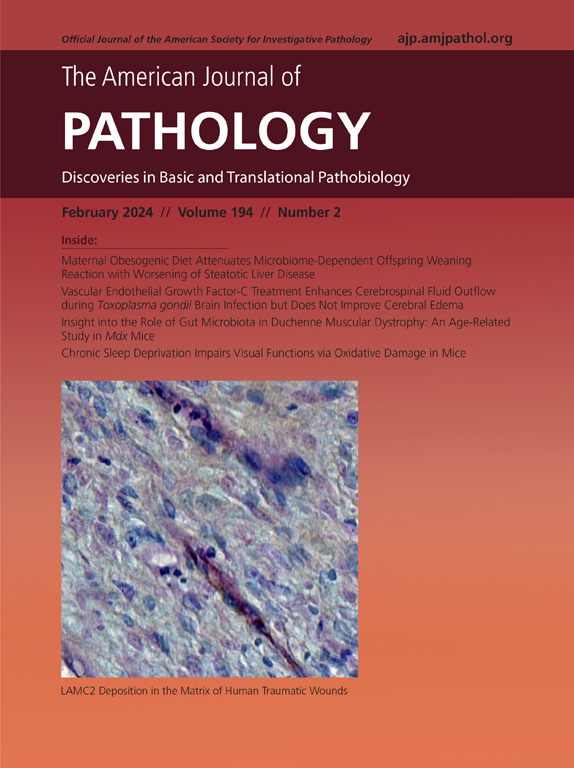Single-Cell Sequencing Reveals the Palmitoylation Landscape in Lung Adenocarcinoma and Identifies ABHD17C as a Novel Biomarker
IF 3.6
2区 医学
Q1 PATHOLOGY
引用次数: 0
Abstract
Protein S-palmitoylation, a reversible posttranslational modification, is crucial for tumor progression. However, the palmitoylation landscape in tumor cells and its variability within different tumor cell populations remain underexplored. This study was designed to analyze protein palmitoylation using 23 palmitoyl-acyltransferases and 7 de-palmitoyl-acyltransferases. Copy number variation, pseudotime, enrichment, and cell-cell communication analyses were used to explore heterogeneity among epithelial cells in lung adenocarcinoma. Palmitoylation levels were elevated in normal epithelial cells, whereas depalmitoylation predominated in tumor-derived cells. As clinical stage advanced, palmitoylation declined and depalmitoylation increased. A C4 epithelial subtype associated with epithelial-to-mesenchymal transition and angiogenesis, marked by low palmitoylation and high depalmitoylation, was identified. This subtype, located at the end of the tumorigenic trajectory, showed intense communication with fibroblasts and endothelial cells but minimal interaction with immune cells, indicating enhanced invasiveness and immune evasion. ABHD17C, a key marker of the C4 subtype, regulated tumor cell proliferation, and its knockdown reduced growth and increased apoptosis. A C4 epithelial subtype linked to lung adenocarcinoma metastasis was identified and ABHD17C emerged as a potential biomarker and therapeutic target.
单细胞测序揭示了肺腺癌中的棕榈酰化景观,并鉴定出ABHD17C是一种新的生物标志物。
蛋白s -棕榈酰化是一种可逆的翻译后修饰,对肿瘤的进展至关重要。然而,肿瘤细胞中的棕榈酰化景观及其在不同肿瘤细胞群中的可变性仍未得到充分研究。我们使用23种棕榈酰转移酶和7种去棕榈酰转移酶分析蛋白棕榈酰化。通过拷贝数变异、假时间、富集和细胞间通讯分析,我们探索了LUAD上皮细胞之间的异质性。棕榈酰化水平在正常上皮细胞中升高,而去棕榈酰化在肿瘤来源的细胞中占优势。随着临床阶段的进展,棕榈酰化减少,去棕榈酰化增加。我们发现C4上皮亚型与上皮向间质转化和血管生成相关,其特征是低棕榈酰化和高去棕榈酰化。该亚型位于肿瘤发生轨迹的末端,与成纤维细胞和内皮细胞有强烈的交流,但与免疫细胞的相互作用很小,表明侵袭性增强和免疫逃避。ABHD17C是C4亚型的关键标记物,可调节肿瘤细胞增殖,敲低ABHD17C可抑制肿瘤细胞生长,增加肿瘤细胞凋亡。我们发现了与LUAD转移相关的C4上皮亚型,并强调了ABHD17C作为潜在的生物标志物和治疗靶点。
本文章由计算机程序翻译,如有差异,请以英文原文为准。
求助全文
约1分钟内获得全文
求助全文
来源期刊
CiteScore
11.40
自引率
0.00%
发文量
178
审稿时长
30 days
期刊介绍:
The American Journal of Pathology, official journal of the American Society for Investigative Pathology, published by Elsevier, Inc., seeks high-quality original research reports, reviews, and commentaries related to the molecular and cellular basis of disease. The editors will consider basic, translational, and clinical investigations that directly address mechanisms of pathogenesis or provide a foundation for future mechanistic inquiries. Examples of such foundational investigations include data mining, identification of biomarkers, molecular pathology, and discovery research. Foundational studies that incorporate deep learning and artificial intelligence are also welcome. High priority is given to studies of human disease and relevant experimental models using molecular, cellular, and organismal approaches.

 求助内容:
求助内容: 应助结果提醒方式:
应助结果提醒方式:


